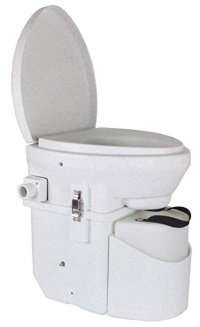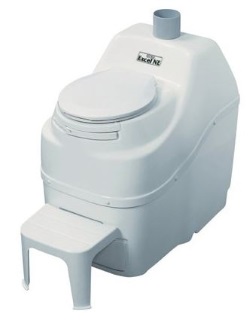What Is A Composting Toilet?
If we take the most basic definition a composting toilet, we could describe it as a commode which turns human waste into compost. Basically, the compost being in the form of black dirt which can then be put back into the soil. It is the end product that is the crucial and in fact the essential goal of a composting toilet, that being the compost which has no odor and is completely harmless.
In other words, this compost is the same as the material that you would pick up in a bag of commercial fertilizer at a nursery or garden center.
When it comes to composting toilets there are many types, from primitive versions to modern counterparts with high tech systems and that appear much like a porcelain toilet fixture, some even flush water just like a normal toilet does.
Nature's Head Self Contained Composting Toilet
 Dims: 22 x 20.5 x 21.7 in. Color: Granite Weight: 28 lbs Shape: Elongated Installation: Floor Mounted
Dims: 22 x 20.5 x 21.7 in. Color: Granite Weight: 28 lbs Shape: Elongated Installation: Floor Mounted
Sun-Mar Excel Non-Electric Self-Contained Composting Toilet
 Dims: 36 x 36 x 28 in. Color: White Weight: 90 lbs
Dims: 36 x 36 x 28 in. Color: White Weight: 90 lbs
Sun-Mar Compact Self-Contained Composting Toilet
 Color: White Weight: 90 lbs.
Color: White Weight: 90 lbs.
More On Composting Toilets
If you have any knowledge of composting toilets of the past, it may surprise you to see how today’s versions have undergone quite an overhaul. Those large and rather unappealing composting toilets of days gone by that came with the potential to smell rather bad are a thing of the past.
Modern Composting Toilets – Designed To Be Odor-Free
Composting toilets today come with a guarantee to be 100% odorless and their design is modern, clean and would quite happily suit any residential bathroom. It’s not just extreme conservationists that are the clients for composting toilets. Even if you find it hard to believe, these could be the next ultra-eco friendly product that is ready to hit the mainstream.
Since modern composting toilets rely on aerobic composting they are different from their primitive versions of the past. Previous composting commodes where often little more than a bucket that had a toilet seat on top, there was no way to aerate the material. If organic matter sits without being aerated, even if we are talking about vegetable peelings, you will soon get a smell.
This is down to the fact that it soon starts to become anaerobic compost, hence decomposition happens at a lower rate and the anaerobic bacteria starts to produce sulfate and methane gasses, these being a byproduct of the process. Modern composting toilets aim to avoid this situation completely.
The Composting Toilet In Your Home!
When we say composting toilets we are not referring to outhouses, trench pits or the likes. In fact, some types of modern composting toilets have traditional features that mean guests in your home may not have the slightest idea that they are not a normal toilet.
Modern composting toilets will often come with a water flushing fixture which is connected by PVC plumbing to the central composting unit which will be in the basement. The main benefit to all of this is that your family, as well as guests to your home, can use a normal flushing toilet and the compost is then taken to the central unit in your basement for it to be processed.
The key facet of today’s composting toilets is the guarantee that they are odorless. Whether you are using a self-contained unit in which the composting drum is within the toilet or the central composting system described above, all of these modern composting toilets have a fan and a venting system which means no odor can enter the bathroom.
For people who have changed from a regular toilet to a composting toilet, they have often noticed that the smell is actually lesser. It’s like having an extra fan in your bathroom only this fan operate inside your toilet.
Most Composting Toilets Need No Water
Granted, you may find it hard to imagine your parents or grandparents changing over from a standard porcelain fixture to a compost toilet, however, it’s time to think about the savings. A lot of the composting toilets available today do not need water which is one of the biggest expenses in keeping a traditional toilet maintained.
Thousands of gallons of water are flushed down the toilet by Americans each day just to move waste to another location. The worst part of it all is that once that wastewater gets to its final destination a lot of energy and chemicals goes into disposing of the waste, treating the water and then making it drinkable once again. With an increasing number of U.S. cities facing water shortages, as well as more costly water bills, the idea of composting toilets may suddenly become a very appealing one.
Modern Composting Toilets Make Money Sense
Once you get over that initial shock of waste management actually happening at your home and not in another location, a lot of people start to see that it makes sense. Whilst composting toilets are expensive it is still only a fraction of the cost to get a new septic tank. As well as the up-front savings, residual savings are part and parcel too, when you take into account reduced water bills and sewer or septic costs.
Certainly, composting toilets make sense for rural and remote areas, however, it’s also true that modern composting toilets are ready to take on urban areas as well. Modern composting toilets are suitable for mainstream residential living, they are just waiting for the public to give them the green light.
Composting Toilets – A Good Alternative
Is a composting toilet a good choice for you? The positives are very attractive – dramatically lower water consumption and they produce a usable organic by-product.
But, they can be costly to purchase and some extra maintenance might be required to keep them in tip-top shape.




